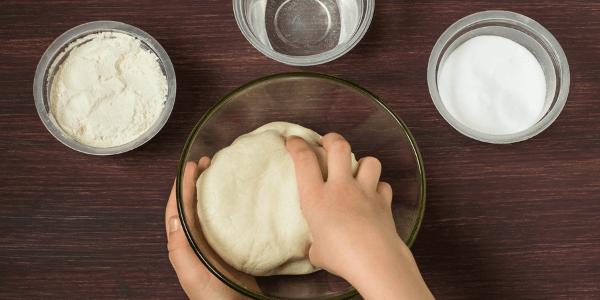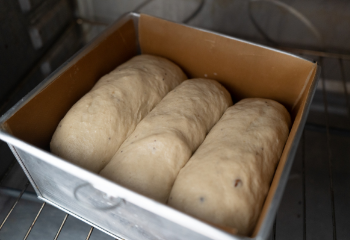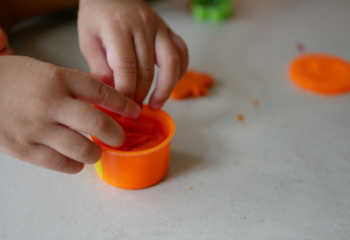
There are two main types of dough that can cause serious issues for dogs: Playdough — homemade and store-bought — and unbaked bread dough.
While the symptoms of toxicity are different for each type of dough, it is best to make sure your pet has no contact with either. And if they do, prompt veterinary attention is needed.
Why Is Playdough Dangerous for Dogs?
Homemade playdough recipes contain flour, cornstarch, sometimes oatmeal, and often moderate to large quantities of salt and cream of tartar. Both the salt and cream of tartar can cause serious issues for your pet.
Symptoms of salt poisoning are neurologic problems, but the most common side effect of toxic doses of salt ingested from play dough is on the heart. The heart must work much harder when there is too much salt in the bloodstream. Dogs with pre-existing heart conditions are at the highest risk for severe side effects.
Cream of tartar (also known as potassium bitartrate) is the powdered form of tartaric acid. Tartaric acid is a known toxin for dogs, and consumption can lead to acute kidney damage.
Signs Your Dog May Have Eaten Playdough
- Seizures
- Coma
- Lack of coordination
- Weakness
- Coughing
- Pale gums
- Ascites: When the abdomen fills with fluid because the heart cannot pump efficiently
- Vomiting
- Diarrhea
- Excessive thirst
Homemade salt dough ornaments are also an item to keep away from your pet, as they can also cause salt toxicity and tartaric acid toxicity.
While these are a popular and fun DIY craft for kids around the holidays, it's important that salt dough ornaments are kept well out of reach of your pets — consider gifting them to family or friends who don't have pets in their home instead of keeping them. Or use this pet-safe dough ornament recipe instead!
What Happens if a Dog Eats Bread Dough?
Unbaked Dough Can Cause Bloat
When raw bread dough is ingested, it expands in the warm and wet environment of a dog’s stomach, just as it would in an oven. This can cause the stomach to bloat and even lead to twisting of the stomach, also called gastric dilatation-volvulus (GDV).

Yeast is Toxic to Dogs
Raw bread dough is also dangerous because the yeast and sugar in the raw dough ferment in the stomach. This means that alcohol is produced and causes toxicity when absorbed into your dog’s bloodstream.
This causes low blood sugar, low body temperature, seizures, breathing difficulty, and ultimately death if not treated as soon as possible.
Raw pizza dough causes the same symptoms as the ingestion of bread dough and should also be treated as an emergency.
Cookie dough does not cause this issue because it does not contain yeast, but it can cause stomach upset if eaten.
Signs Your Dog May Have Eaten Dough
Symptoms of dough ingestion include:
- Retching: trying to vomit with nothing coming up
- Swollen and distended stomach
- Weakness and even collapse
How Much Bread Dough is Toxic to Dogs?
Since any amount of raw bread dough is considered toxic, it’s always best to contact your veterinarian, emergency clinic, or pet poison hotline if your pup may have ingested some. Of course, the size of the dog does make a difference. If a Great Dane has eaten a tablespoon of dough, it is likely to be of less emergent concern than if a three-pound chihuahua has eaten the same amount. But in either scenario, you should still contact your veterinarian, emergency clinic, or pet poison hotline immediately.
Click here for Pet Poison Control Hotline contact information.
What You Should Do if Your Dog Has Eaten Dough
If you suspect your pet ingested bread dough or playdough, contact your veterinarian or 24-hour emergency clinic immediately.
Time is of the essence since the dough will start to expand once it's in the stomach. If prompt veterinary care is available, your dog may just need an injection to induce vomiting. However, it depends on how much dough was ingested and the length of time between ingestion and treatment.
Never attempt to induce vomiting at home unless directed to do so by your veterinarian. You can give your dog some cold water to drink if you know they have gotten into raw dough, as this can slow the fermentation process.

Treatment for Dough Ingestion
As noted above, sometimes vomiting can be induced to remove the dough from the stomach. But this is rarely the case, and usually, more intensive treatment is needed. Your dog’s stomach may need to be "lavaged," meaning that liquid is moved into the gastrointestinal cavity through a tube — sometimes, this can help with the removal of the mass of dough. If vomiting and lavage are unsuccessful, then surgical removal may be necessary.
If the yeast has fermented long enough to also cause alcohol toxicity, your pup will need to go on intravenous (IV) fluids to manage blood pressure and electrolyte abnormalities, as well as help with their heart function. Various medications will also be used to stabilize any issues caused by the alcohol that was absorbed.
If playdough or salt ornaments are ingested, your pet will need to go on IV fluids to restore electrolytes back to normal and medications to correct any heart arrhythmias.
Prevention of Dough Toxicity
Prevention is always preferred (and cheaper) than treatment. Since time is of the essence with dough ingestion, it is critical to make sure that everyone in your home is aware of the dangers that dough can cause for your pup.
The key to preventing your dog from ever experiencing bread or playdough toxicity is not to let them ever ingest it, which of course, is easier said than done. With some careful planning, hopefully, you will never need to experience this emergency.

Playdough Toxicity Prevention
- When using playdough, keep your dog in their crate or in a separate room.
- Make sure your children know that playdough is dangerous for dogs, and don’t let your kids run around with the playdough.
- Store playdough in pet-proof containers that are out of reach of your dog’s curious nose.
- Make your own pet-safe salt-free playdough.
- The Play-Doh™ brand of playdough contains a smaller amount of salt than most homemade doughs but should still be used with caution around pets.
Raw Bread Dough and Pizza Dough Prevention
- Never leave raw dough on a counter to rise. Instead, keep it in the oven or microwave.
- Never dispose of unused or old bread dough in a trash can inside your home.
- Make sure that your pup is in a different room or crated while preparing bread dough to make sure counter-surfing dogs cannot snatch the dough when you're distracted.
If treated quickly, most dogs will recover from dough poisoning with no long-term side effects. However, every minute that treatment is delayed allows for more serious issues to develop.
Usually, dogs that don’t recover from eating dough are the ones that do not receive care quickly. This can lead to the alcohol poisoning noted above, which can lead to death. So never take a “wait and see” approach if your pooch has ingested dough, so that they can be one of the many who recover without any serious issues.



